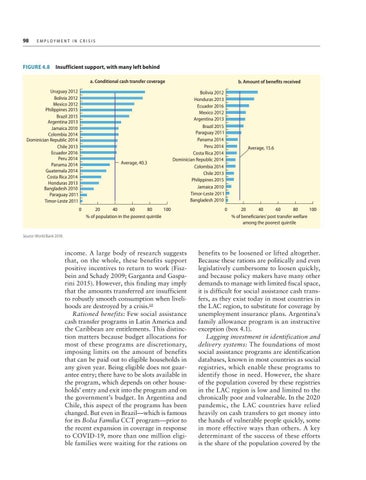98 E m p l o y m e n t
in Crisis
FIGURE 4.8 Insufficient support, with many left behind a. Conditional cash transfer coverage Uruguay 2012 Bolivia 2012 Mexico 2012 Philippines 2015 Brazil 2015 Argentina 2013 Jamaica 2010 Colombia 2014 Dominician Republic 2014 Chile 2013 Ecuador 2016 Peru 2014 Panama 2014 Guatemala 2014 Costa Rica 2014 Honduras 2013 Bangladesh 2010 Paraguay 2011 Timor-Leste 2011
Average, 40.3
0
b. Amount of benefits received Bolivia 2012 Honduras 2013 Ecuador 2016 Mexico 2012 Argentina 2013 Brazil 2015 Paraguay 2011 Panama 2014 Peru 2014 Costa Rica 2014 Dominician Republic 2014 Colombia 2014 Chile 2013 Philippines 2015 Jamaica 2010 Timor-Leste 2011 Bangladesh 2010
80 100 60 20 40 % of population in the poorest quintile
Average, 15.6
0
20 40 60 80 100 % of beneficiaries’ post transfer welfare among the poorest quintile
Source: World Bank 2018.
income. A large body of research suggests that, on the whole, these benefits support positive incentives to return to work (Fiszbein and Schady 2009; Garganta and Gasparini 2015). However, this finding may imply that the amounts transferred are insufficient to robustly smooth consumption when livelihoods are destroyed by a crisis.10 Rationed benefits: Few social assistance cash transfer programs in Latin America and the Caribbean are entitlements. This distinction matters because budget allocations for most of these programs are discretionary, imposing limits on the amount of benefits that can be paid out to eligible households in any given year. Being eligible does not guarantee entry; there have to be slots available in the program, which depends on other households’ entry and exit into the program and on the government’s budget. In Argentina and Chile, this aspect of the programs has been changed. But even in Brazil—which is famous for its Bolsa Familia CCT program—prior to the recent expansion in coverage in response to COVID-19, more than one million eligible families were waiting for the rations on
benefits to be loosened or lifted altogether. Because these rations are politically and even legislatively cumbersome to loosen quickly, and because policy makers have many other demands to manage with limited fiscal space, it is difficult for social assistance cash transfers, as they exist today in most countries in the LAC region, to substitute for coverage by unemployment insurance plans. Argentina’s family allowance program is an instructive exception (box 4.1). Lagging investment in identification and delivery systems: The foundations of most social assistance programs are identification databases, known in most countries as social registries, which enable these programs to identify those in need. However, the share of the population covered by these registries in the LAC region is low and limited to the chronically poor and vulnerable. In the 2020 pandemic, the LAC countries have relied heavily on cash transfers to get money into the hands of vulnerable people quickly, some in more effective ways than others. A key determinant of the success of these efforts is the share of the population covered by the

